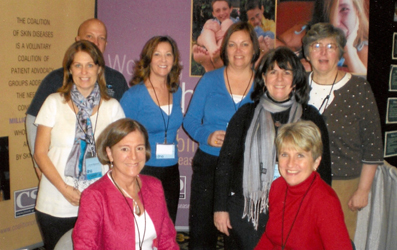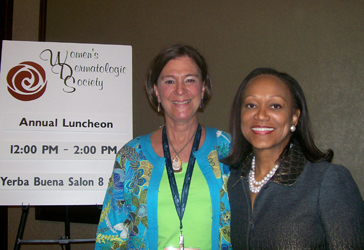

|
Conferences! When Conventional Treatments haven't worked... VSI Member Discusses Her Personal "Alternative Treatment?" VSI Member Jeff Pierce - A Vitiligo Journey to Repigmentation! Update on Childhood Vitiligo, Treatments, and Outcomes Research Update Clinical Trials Now Enrolling Behind the Scenes Read the Spring 2009 Newsletter here!
You Can Make a Difference Today, for Someone in the Vitiligo Community
By making a donation to VSI as a Supporting Member; your gift will make a difference in the life of another person living with vitiligo. Over 50,000 people with vitiligo have contacted VSI for help and we respond daily to hundreds of people coming to us for information and support. As we depend on donations from the public to serve vitiligo patients, your gift is critically needed. When you join as a Supporting Member, you will have the satisfaction of knowing you are helping others whose lives have been affected by vitiligo. You will also gain additional Supporting Member Benefits. If you are already a Supporting Member, an additional gift is welcome and gratefully appreciated. Thank you for your support and for enabling us to provide critically-needed services to this community. Do you have a vacation home or time share you're not using for a weekend or week that you would consider making available to a VSI member for their donation to VSI. Do you have too much "STUFF"? Would you consider listing a few items on Craigslist or Ebay then donating the proceeds to VSI? Could you organize a covered dish dinner/talent show at your church; charge a small fee to attend the Talent show and donate the proceeds to VSI? We'd love to have photos to include in a newsletter! Do you know of a shop that might host an "open house" or "Tasting", donating a portion of the proceeds to VSI? Do you have a good brain for fundraising ideas? If so- let us know your ideas at [email protected] |
|
Online VitiligoSupport.org Use our Contact Form (preferred and generally the FASTEST way to get a response) Postal Mail Address Vitiligo Support International P.O. Box 4008 Valley Village, CA 91617-0008 Phone (818) 752-9002 |
CONFERENCES!
Save The Dates!
Come and Meet the Experts and Network with Others!
Vitiligo Support International (VSI) is offering regional and local educational conferences in different areas of the country rather than the larger, national events we've sponsored in the past. We hope these smaller, one-day seminars will be more accessible to more people and require less travel and cost.
Go to the: VSI Meetings Page for additional information and to check for a Seminar near you!
When Conventional Treatments haven't worked...
For many people with vitiligo, conventional dermatology is helpful. But if you are not getting the results you'd hoped for, it may be time to add some new tools, according to Dr. Ted Grossbart, psychologist and member of VSI's Medical and Scientific Advisory Committee.
An active supporter of the self-care movement, Dr Grossbart explains; "Although heredity, viruses, bacteria, allergies and chemical irritants play a central role in skin problems, stress and emotions do cause some skin problems and trigger or heighten others.
Rather than dividing illness into "emotional" or "physical," I see emotions as one factor in all skin diseases. Emotional stress may be the sole cause of a few symptoms, but is more typically a trigger of the flare-ups of an ongoing medical condition.
Recent studies tell us that between thirty and sixty percent of all people who seek medical attention for a skin problem experience significant underlying emotional turmoil. This is critically important because emotional problems can keep even the most sophisticated medical treatment from working."
How important is the emotional factor in your illness?
Take this quick vitiligo quiz to learn more.
- Did your pigment loss begin or recur after emotionally significant events such as: vacations, hospitalizations, business trips, moving to a new house or new school or a divorce in the family?
- Is your condition more stubborn, severe, or recurrent than your doctor expects?
- Are usually effective treatments not working for you?
- Do treatments work for a while, but not for long?
- Do your symptoms get worse during or after particularly stressful periods in your life?
- Is your level of distress and concern about your skin unusually high?
- Do you find that you are avoiding social situations?
- Do you find you are selecting and wearing clothing which may or may not be climate appropriate in order to conceal your vitiligo?
Ted A. Grossbart, Ph.D. is a licensed clinical psychologist in private practice in Boston. He is a senior supervisor at the Massachusetts Mental Health Center, and an Assistant Clinical Professor of Psychology at Harvard Medical School. His best known writing, his book: Skin Deep: A Mind/Body Program for Healthy Skin can be found by clicking the previous link to purchase through Amazon's VSI library and Store.
Visit Dr. Grossbart's "Skin Deep" Website for more information on a wide range of multimedia psychodermatology resources. For more information, you may contact Dr Grossbart at [email protected].
FYI
Research shows that stress is a trigger and negative factor in autoimmune disease. As vitiligo is an autoimmune disorder, it is important to be aware of the role of stress on your skin. Stress does not cause autoimmune disease; that part is genetic, but if you have the gene, then stress can open the door to your immune system leaving you vulnerable to an attack.
Click here to read more about the effect of emotional stress on autoimmune disease
Click here to view a PubMed abstract on The Psychological Impact of Vitiligo and the Need for Dermatologists to Be Aware of Treatments to Offer Patients
VSI Member Discusses Her Personal "Alternative Treatment?"
VSI board member Jann Breslin (Jannz) has had vitiligo for 22 years and subsequently developed two additional autoimmune diseases, Hashimoto's thyroid disease and Sjogren's. Jann opted to take an alternative approach to treatment.
As Jann's health began to deteriorate, her careful research led to the decision to forgo conventional medicine's use of immune-suppressing drugs and instead to "use my holistic doctors' advice and develop a new lifestyle approach, taking the whole body into consideration and addressing the root cause rather than just treating symptoms."
More from Jann...
In creating a new lifestyle approach I began to focus more on my nutrition and incorporated more supplements into my daily regimen. I learned to only start one new supplement at a time so that you can attribute any negative or positive response to a specific supplement.
In addition to my supplement regimen, a naturopath doctor suggested I investigate Low Dose Naltrexone Therapy (LDN) to stop the progression of my autoimmune disease.
LDN is an off-label use of an FDA approved drug called 'Naltrexone'. Naltrexone is typically prescribed in 50mg doses however in LDN it's prescribed in a very low dose; 1.5mg - 4.5mg. LDN works on the premise that our endorphins are playing a governing role in the modulation of our immune system. In diseases that have an immune response at their root, LDN helps to rebalance the immune system. As an immunomodulator, it promotes homeostasis; it helps the body to heal itself. LDN is not a cure, but may stop disease progression and provide some symptom relief.
I've been using LDN since Feb 08. I have my sense of well-being back, my thyroid function has improved...and yes, I've achieved some freckling on my hands. I'm using LDN to stop my disease progression but the freckling is a nice bonus.
For more information about LDN read The Promise of Low Dose Naltrexone Therapy by Elaine Moore To purchase this book on Amazon.com and support VSI with your purchase, click here: The Promise Of Low Dose Naltrexone Therapy: Potential Benefits in Cancer, Autoimmune, Neurological and Infectious Disorders. It's an excellent reference. Many doctors are unaware of LDN, so I'd suggest you share it with your doctor.
I've also developed a yoga practice. The Anusara style yoga that I practice has gone beyond maintaining my flexibility. It has become a path to how I connect to my spirituality - it keeps me centered, balanced -- and I think this is critical to my health.
My journey to achieving optimal health is meant to be dynamic, not a rigid path. I do the best I can�some weeks my nutrition is optimal�but I do eat hamburgers and may drink a diet soda occasionally. Life is short and hard� I want to enjoy it. Read more about the supplements and tests that I use on my user profile.
VSI does not endorse or recommend any treatments, alternative or otherwise. Please consult your doctor before beginning or following any therapy described in this newsletter.
VSI Member Jeff Pierce
A Vitiligo Journey to Repigmentation!
By Jeff Pierce
 I was diagnosed with vitiligo when I was 4 years old. Year after year, I went to the doctor's office for a physical exam and was told there was nothing I could do about my vitiligo. I was told I should just be grateful I didn't have anything worse. That news was so hard for me to understand and it made me feel so alone.
I was diagnosed with vitiligo when I was 4 years old. Year after year, I went to the doctor's office for a physical exam and was told there was nothing I could do about my vitiligo. I was told I should just be grateful I didn't have anything worse. That news was so hard for me to understand and it made me feel so alone.VSI had a different message for me. It was a message of hope and understanding that I had been searching for my whole life. It has been a place I can go to learn about all aspects of vitiligo, such as treatment options, patient coping techniques, current research, and theories of its cause. After spending some time with VSI, I gained the knowledge and confidence to do something about my vitiligo. The impact on my life has been tremendous, and I'm so grateful to everyone involved. The confidence and sense of well being I have gained from treating my vitiligo has had a positive impact on many other areas of my life.
Treating my vitiligo and learning with other members of VSI, led me to surface and address emotional issues I've long carried related to my vitiligo. I am now more comfortable explaining vitiligo to others, and I no longer feel alone or the desire to hide. I feel less inhibited and more hungry to make contributions to the world. VSI has reinforced my belief that love and meaning come through helping others. Thanks VSI!
VSI has been there for me when I needed them the most. The staff and community provided the guidance and support I needed to regain much of the pigment I had lost in the 28 years of having vitiligo. Before treatment, vitiligo patches covered 30% of my body. After one year of a NB-UVB focused treatment, vitiligo patches cover only 12% of my body.
Jeff is a Supporting Member of VSI. (PPP220) To see his treatment progress pictures, visit the Supporting Member Galleries.
If you are not currently a Supporting Member, you can upgrade here: Supporting Member
If you are not currently a Supporting Member, you can upgrade here: Supporting Member
Update on Childhood Vitiligo, Treatments, and Outcomes
Dr. Nanette Silverberg, member of VSI's Medical and Scientific Advisory Committee reports:
Vitiligo vulgaris can affect 0.4-1 of the population, with half of cases starting in childhood. It has been described that children with a family history of autoimmune diseases will start to have vitiligo before children who have no affected family members. When we say autoimmune diseases, the most common in the general population is actually thyroid disease, with diabetes, rheumatoid arthritis, lupus and colitis representing other less common forms of autoimmunity. Localized segmental disease rarely has a familial component, while generalized vitiligo is felt to be caused partially by genetic tendency, and partially by a trigger that sets off initial disease. Dr. Richard Spritz has identified a gene (NALP1) that is associated with vitiligo in specific populations. He continues to collect samples from a variety of ethnicities to determine more about the genetic basis of vitiligo. At our Skin of Color center, we help him collect samples from patients of a broad ethnic variety. Any skin tone, age or ethnic background of patient can be affected by vitiligo.
In the past, I have published data looking at novel treatment regimens for vitiligo including topical corticosteroids with calcipotriene and topical calcineurin inhibitors (tacrolimus), with good results in many patients. Developing a treatment plan with your physician is important. Do not become disheartened if a certain therapy does not work. For many patients, their vitiligo was untreatable prior to tacrolimus becoming available. For others, topical corticosteroids will be the magical therapy. Still other patients will respond well to phototherapy. One thing is certain; treatments take time to show results. For creams 2-3 months on the face or 6-8 months on the body is required. For phototherapy in a booth, it can take 2 months to start getting color and 1-2 years to reach maximum response. Finally for excimer laser, as many as 12 sessions may be needed to see initial results, and often 48-64 for maximum results.
One controversial area in childhood vitiligo is whether there is a need to perform laboratory testing. I am a strong advocate of laboratory testing in certain settings. When undergoing phototherapy, screening for lupus using an antinuclear antibody test is crucial to prevent severe sunburn reactions. I have published data on thyroid testing in my New York-based practice. Testing will yield results in as much as a quarter of children with generalized disease, but none with segmental vitiligo. Performing thyroid function tests on a periodic basis in children with vitiligo is a good idea. I typically add these tests on to annual labs to avoid the pain of an extra needle stick.
For more information, see this PubMed Study When To Begin Thyroid Testing Children with Vitiligo
Research Update
Research continues into many aspects of vitiligo. Below are some ongoing studies located using the term vitiligo, on Pubmed, which is a service of the US National Library of Medicine and the National Institutes of Health
For Your Doctor or Insurance Company: Study Shows that EARLY Treatment is Necessary!
Good Foods - Bad Foods. Can Your Diet Affect Your vitiligo?
Clinical Trials Now Enrolling
Click links below to see if you qualify
Transplant Procedure For Vitiligo Patients
Compensated Study to Discover Targets for New Vitiligo Treatments
Behind the Scenes
VSI's Executive Director, Jackie Gardner, recently attended the Dermatology Nurses Association (DNA) Annual Meeting in San Francisco, CA from March 4-7, 2009. The DNA is comprised of 3,000+ RNs, NPs, LPN/LVNs, Medical Assistants, and Other Associate Members, with a breakdown of 71% Nurses, 21% Medical Assistants and 8% Other.
The Coalition of Skin Diseases (CSD) had an exhibit, and VSI was one of the member organizations represented. Jackie was on hand at the booth each day to hand out VSI brochures and answer questions related to vitiligo. This was a fantastic experience, as the nurses generally spend the most time with the patients and are interested in providing them with the most up- to-date information.
Jackie spoke with nurses on topics such as how long to treat a patient before looking for a response, how to tell if a patient has hit a plateau with a treatment, and the different ways a patient might respond to treatment. For example, not all patients will freckle with light treatment; some areas will close in from the outside edges, so without accurate measurements or photographs, it can be difficult to tell how well the treatment is working.
Many nurses took VSI brochures and many others requested to have some mailed to their office for their dermatologists to pass out to their vitiligo patients.

Shown here are several CSD members who attended the DNA meeting, including Jackie Gardner (seated left), VSI Executive Director and CSD President; and Gail Zimmerman (seated right), founding member and first President of CSD and recently retired President and CEO of the National Psoriasis Foundation.
Jackie also attended the American Academy of Dermatology's (AAD) Annual Meeting held in San Francisco from March 6-9, 2009. VSI was represented at the CSD's exhibit at the AAD's Annual meeting and had the opportunity to again pass out brochures. The vitiligo brochures went like lighting this year. It was a good thing she'd brought extras in her suitcase or they'd have run completely out the first day!
During the AAD's 4 day meeting, Jackie had the opportunity to attend the Women's Dermatologic Society (WDS) Annual Meeting and luncheon. The WDS is the nation's third-largest dermatology organization. (P Jackie was one of very few patient advocates in attendance and found the experience invaluable with regard to the ability to share the patient's perspective with so many of these women dermatologists.
While there she had a chance to catch of few minutes with the Chairman of VSI's Medical and Scientific Advisory Committee, Dr Pearl Grimes.
